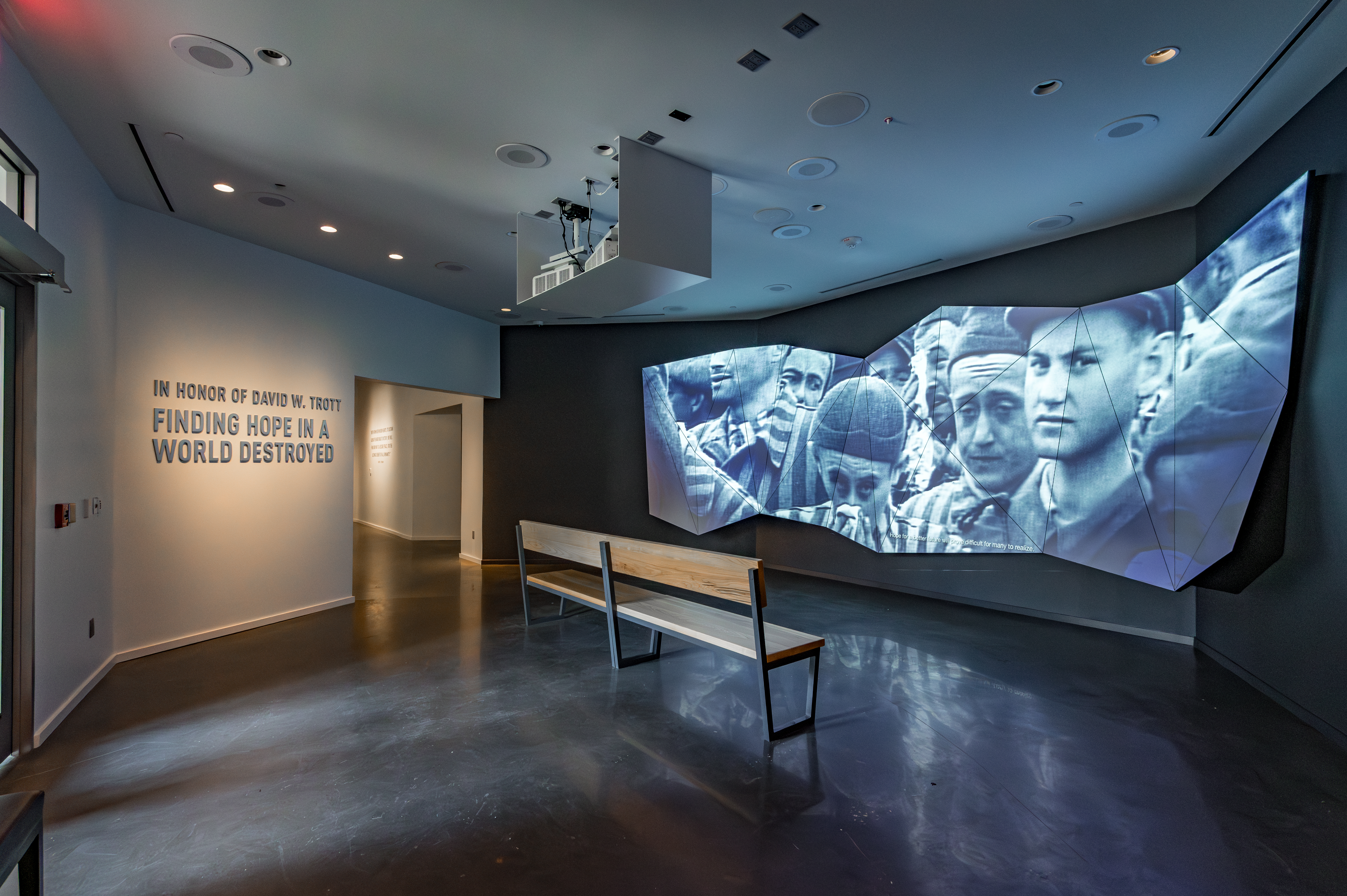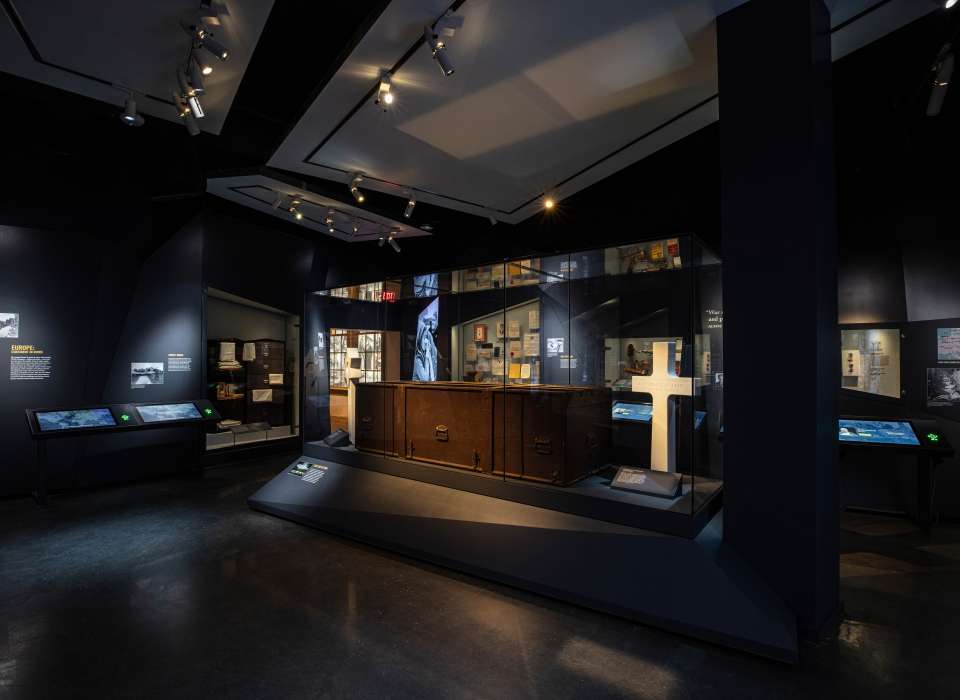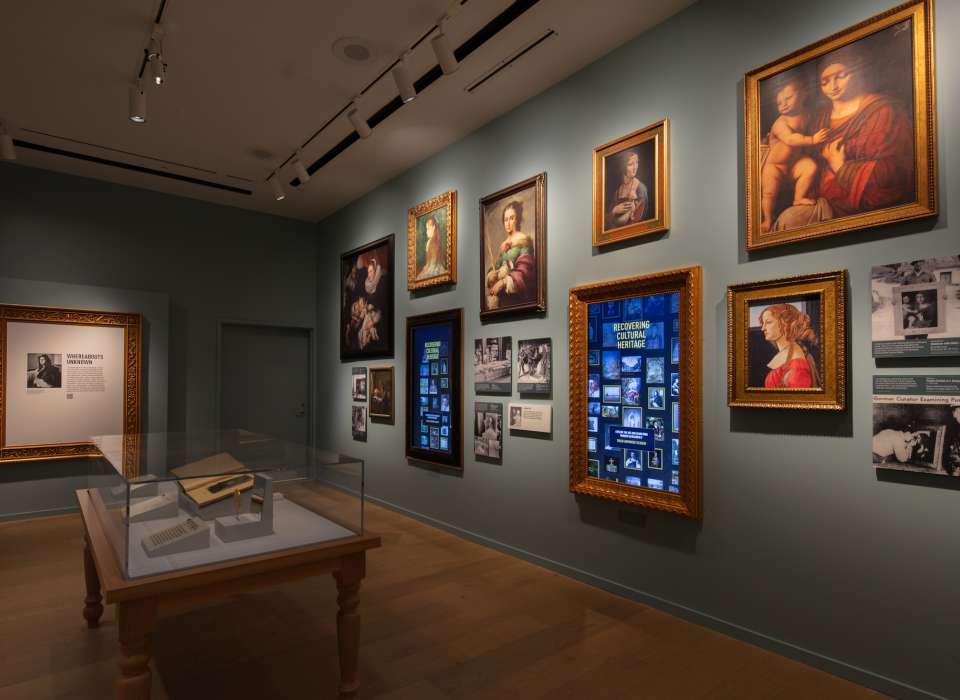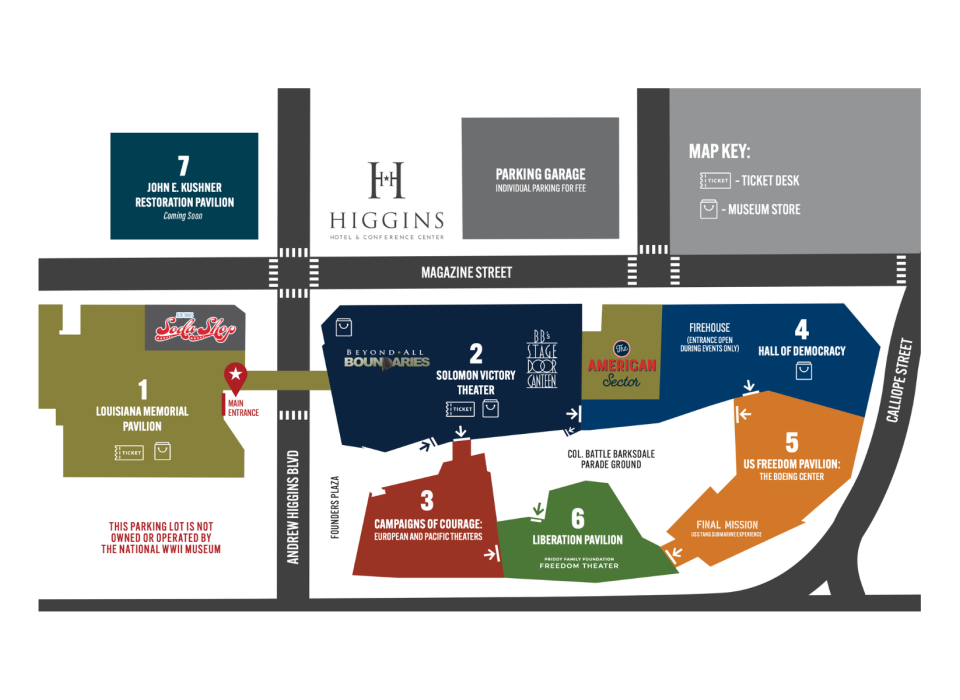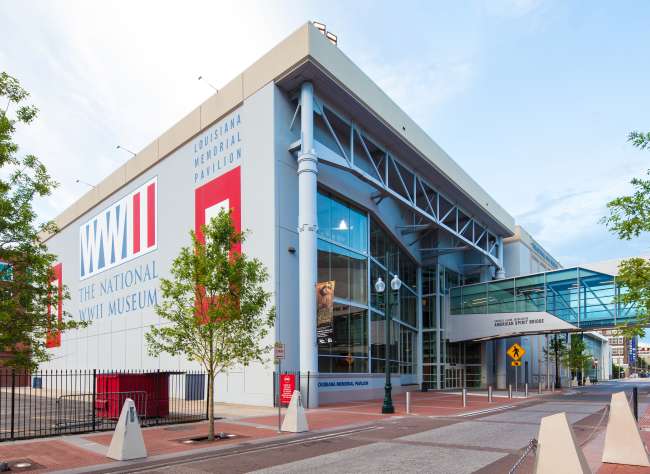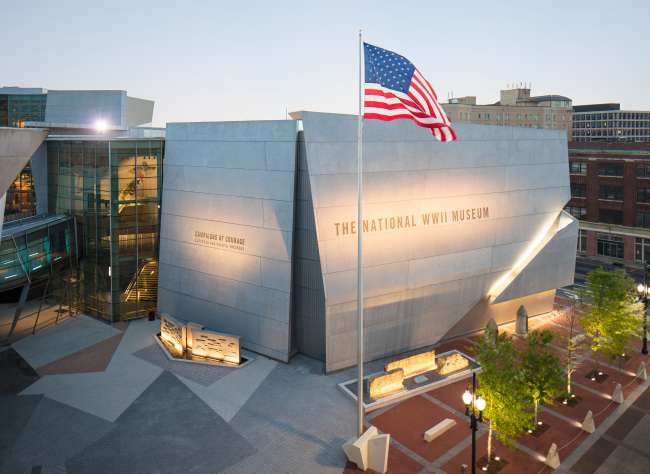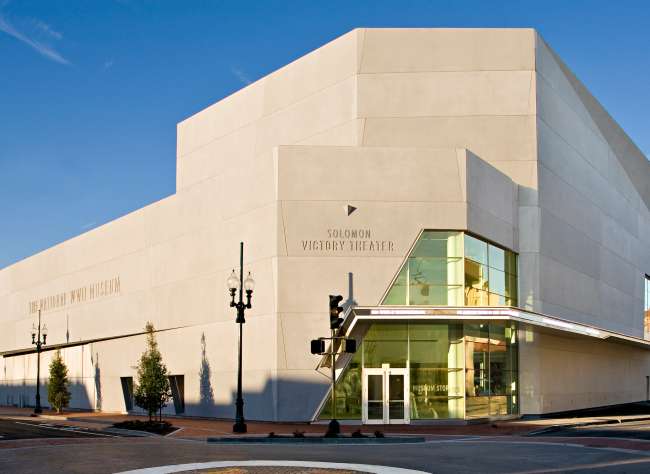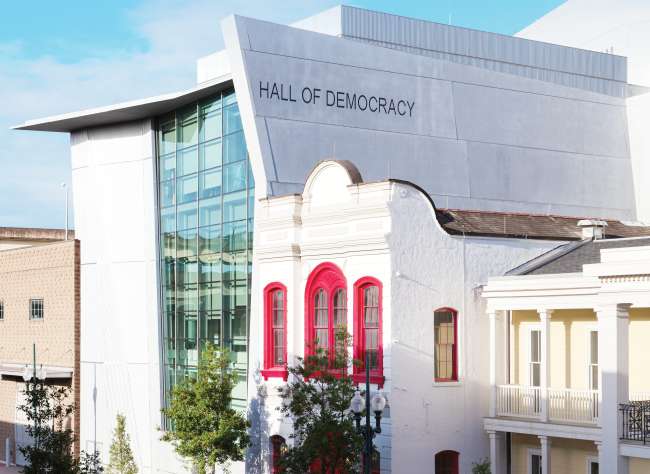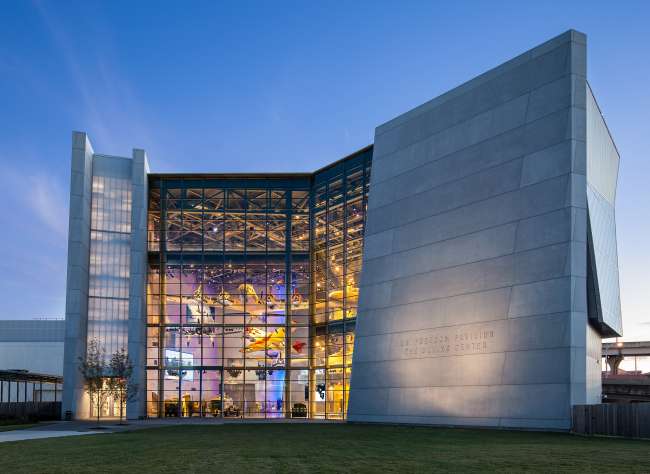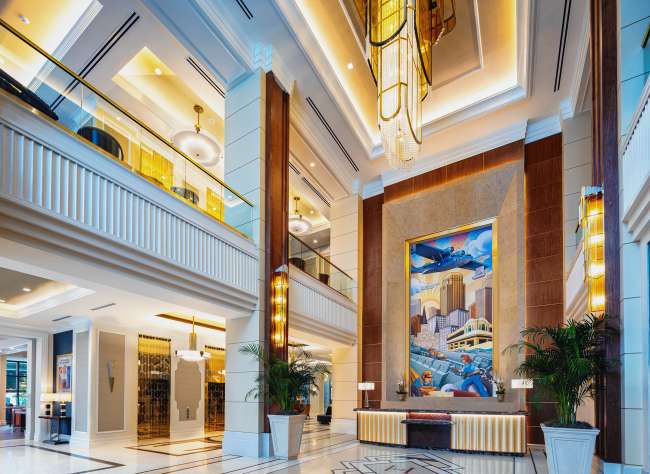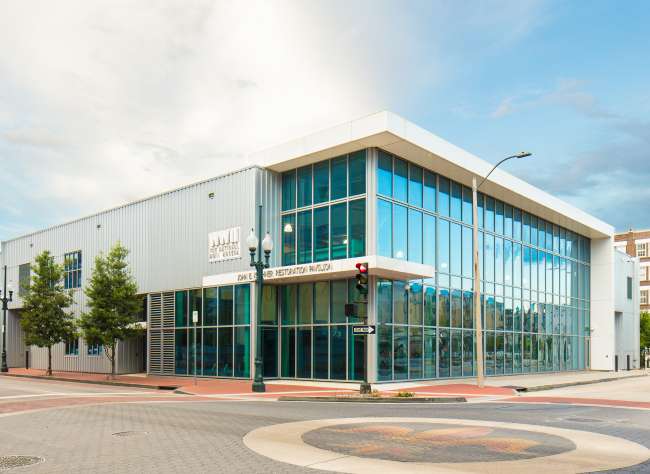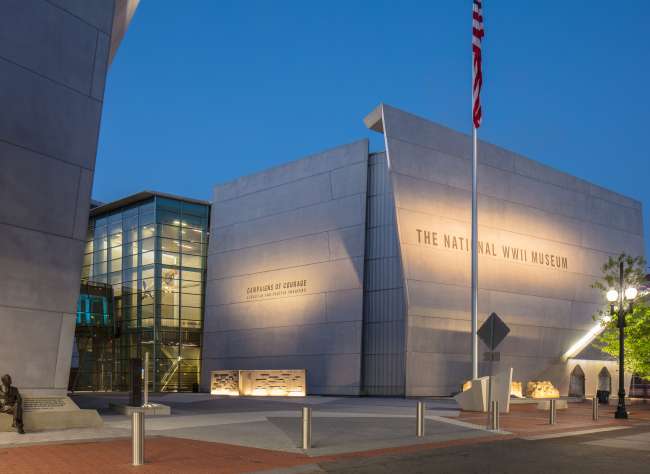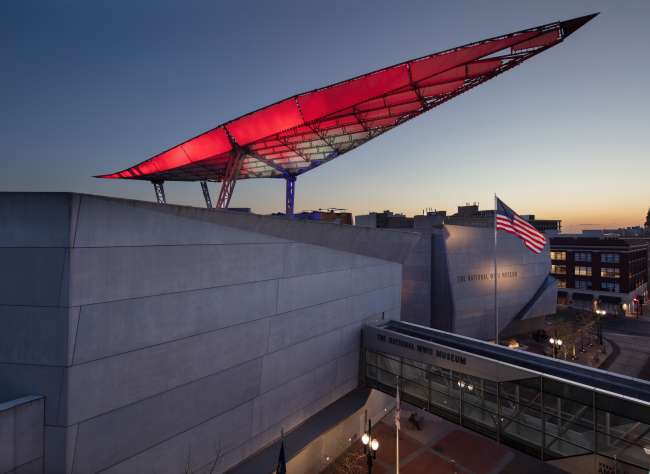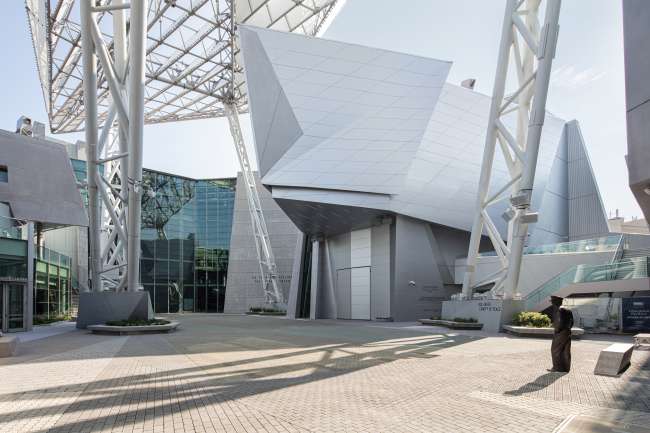In Honor of David W. Trott
Trott Family Philanthropies
Liberation Pavilion’s first floor, In Honor of David W. Trott Finding Hope in a World Destroyed, honors the sacrifices of the WWII generation and explores the immense cost of the war with exhibits on the Holocaust, Anne Frank, faith in wartime, and the Monuments Men and Women. Stories of both loss and liberation reveal the true horror of the conflict as victors and vanquished alike began the tough task of rebuilding their shattered world.
GALLERY DESCRIPTIONS
Those Who Served
While war has always required service and sacrifice, World War II placed unprecedented demands on the men and women who fought it. Service personnel fought in all conditions: the jungles of the South Pacific, the deserts of North Africa, and the dense urban terrain of Western Europe. Never before had the battles been so large or the military technology so deadly. Over 16 million Americans donned their country’s uniform, and more than 414,000 of them did not return to their homes and families.
Made possible through a gift from David and Rosemarie S. DeVido and DeVido Family — John, JoAnn, Phyllis, Raymond, Carol, Shana and Lara Martin DeVido, Leela and Meena Ramakrishnan, and the Stirnimann Family — Katharina, Clara, Antoinette, Hans, Joseph, Elsbeth, Rita, Karl and Albin, in Honor of Beatrice and Joseph DeVido, USN, Brigitta and Johann Stirnimann, Hosted Refugees in Switzerland.
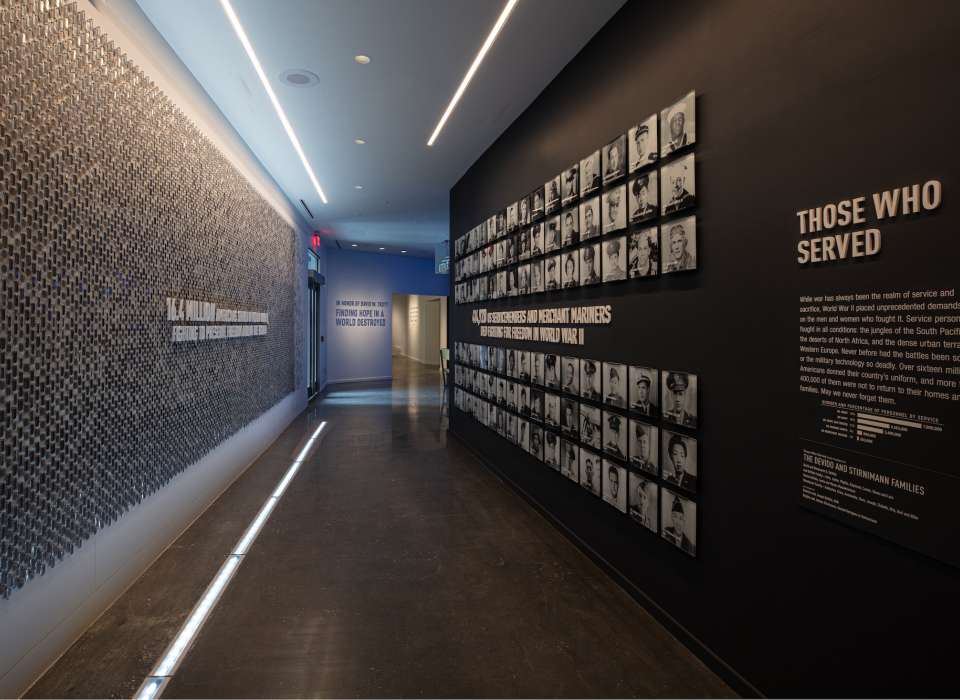
Liberation & Loss
As an introduction to the exhibit floor, the Orientation Theater offers a film focusing on how liberation led to immediate celebrations and visions of a hopeful future for millions of Americans. Tragedy also remained as many carried the war’s scars—from physical and mental wounds to the death of loved ones—for the rest of their lives. Some hopes for a better future proved difficult to realize, and many Americans discovered that the battlefield is not the final struggle: the fight for freedom is not over—indeed, it will never truly end.
Made possible through a gift from Perry and Marty Granoff.
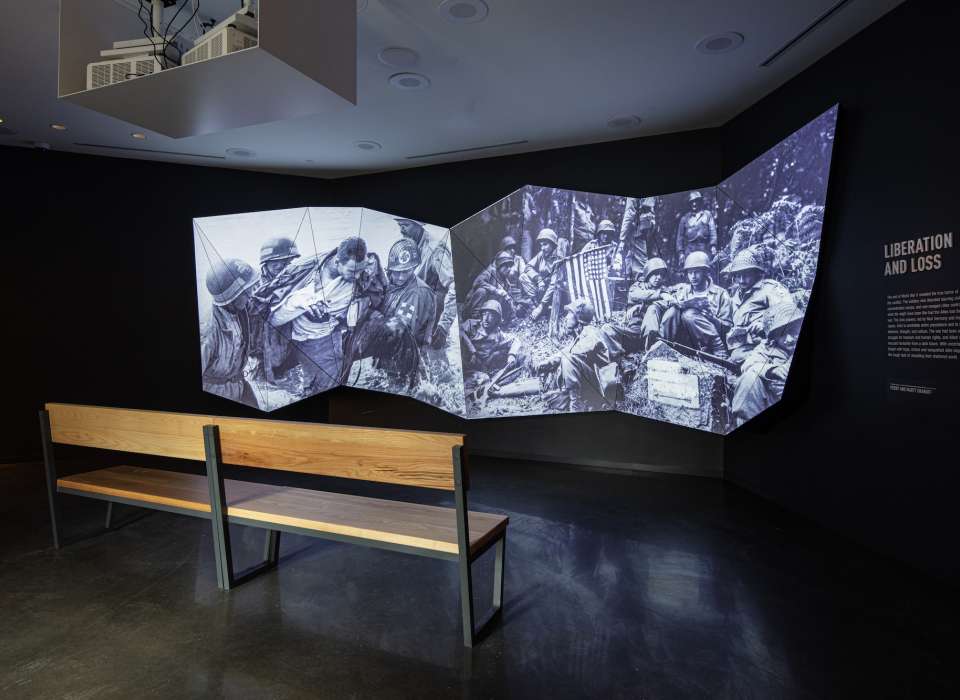
The Cost of Victory
The human cost of World War II was enormous, with at least 65 million people dead, cities demolished, and entire continents ravaged. Even after the fighting ended in 1945, suffering and violence continued to engulf the globe. Famine struck Europe and Asia, while political uprisings and civil wars shook countries only recently liberated from Axis occupation. All over the world, men and women returned home to discover that familiar people and places were forever changed. In the midst of victory parades, families mourned their lost loved ones. How could anyone truly comprehend such losses?
Made possible through a gift from The Swieca Family, New York, NY, in Memory of the Swieca and Lieberman family members who perished in the Holocaust. Additional support provided by John and Evonne Yonover and Mrs. Betty B. Dettre in Memory of Major General Rexford H. Dettre Jr.
“And Then They Came for Me”
Divided into three sections, this gallery examines the Holocaust and its tragic legacy. The first and second parts explain the rise of Nazi terror and persecution of Europe’s Jewish population through the story of Anne Frank. The third focuses on the concentration camp system and the liberation of the camps. The gallery includes an immersive media experience using the words of Anne Frank in a re-creation of the Secret Annex, as well as a projection highlighting the liberation of the camps and a listening station with testimonies from Holocaust survivors.
The Conference on Jewish Material Claims Against Germany Supported by the Foundation Remembrance, Responsibility and Future and the German Federal Ministry of Finance
Made possible through a gift from The Lupin Foundation in Memory of E. Ralph Lupin, M.D., BGen LA National Guard. Additional support provided by Oscar J. Tolmas Charitable Trust; Kay and Fred Zeidman, In Memory of 1st Lt. Irving Hubert Selber, US Army Air Forces, and Staff Sergeant Morris Benjamin Zeidman, US Army Corps of Engineers
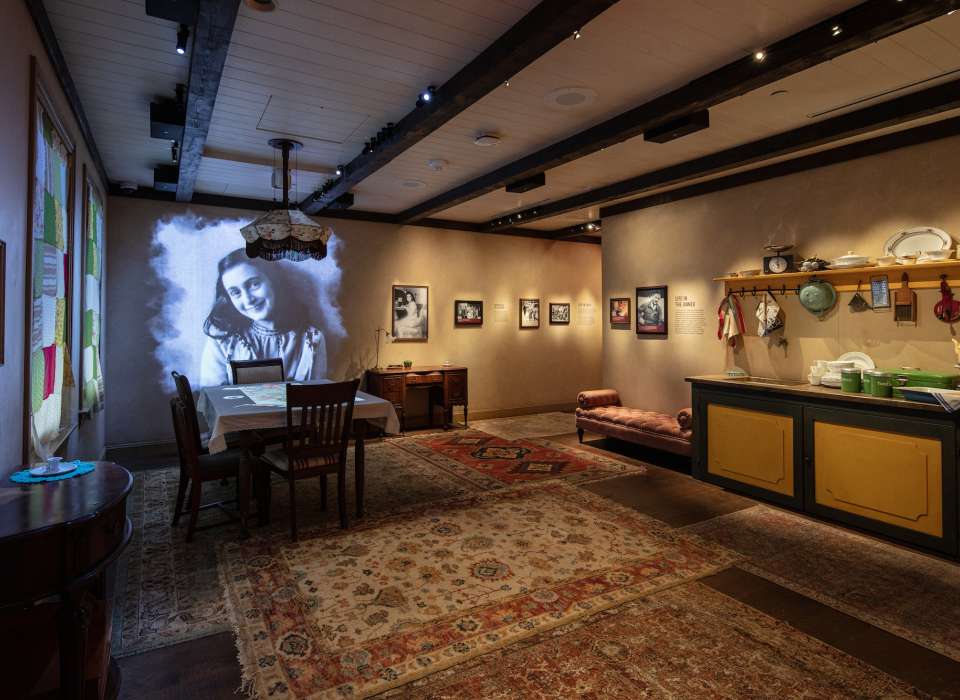
Pam and Mark Rubin Liberation Theater
The panoramic Pam and Mark Rubin Liberation Theater features a 30-minute production with powerful personal testimonies capturing the complicated emotions felt by liberated Holocaust survivors as well as the US servicemembers who freed them. Survivors’ first feelings of hope and the joy of freedom at the moment of liberation from almost certain death are balanced only by the stark realization of their great loss.
Made possible through a gift from Pam and Mark Rubin, a child survivor of the Holocaust and Trustee of The National WWII Museum. Additional support provided by Morris Family Foundation.
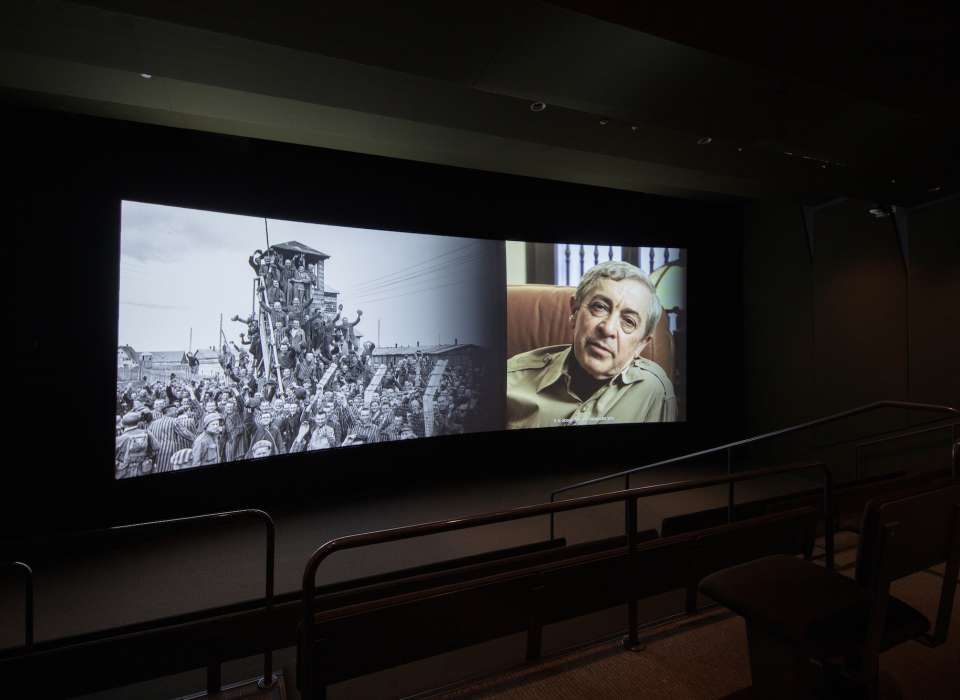
Faith in Wartime
American servicemembers held widely diverse beliefs, but their faiths shared universal themes of devotion, sacrifice, and service. American religious leaders viewed the war as both a military struggle and a spiritual one, pitting human dignity against totalitarianism. At home, many who worried about their loved ones turned to their religious beliefs for comfort. On the battlefield, experiencing the worst of humanity shattered the faith of some servicemembers. Others sought solace in their beliefs. For many, religious faith, faith in each other, and faith in themselves sustained them through the horrors of combat. Featured in the central position of this gallery are the Four Chaplains, who were aboard the SS Dorchester and sacrificed their lives to aid their brothers-in-arms when the ship was struck by a German U-boat torpedo.
Made possible through a gift from Baptist Community Ministries. Additional support provided by Lilly Endowment Inc.
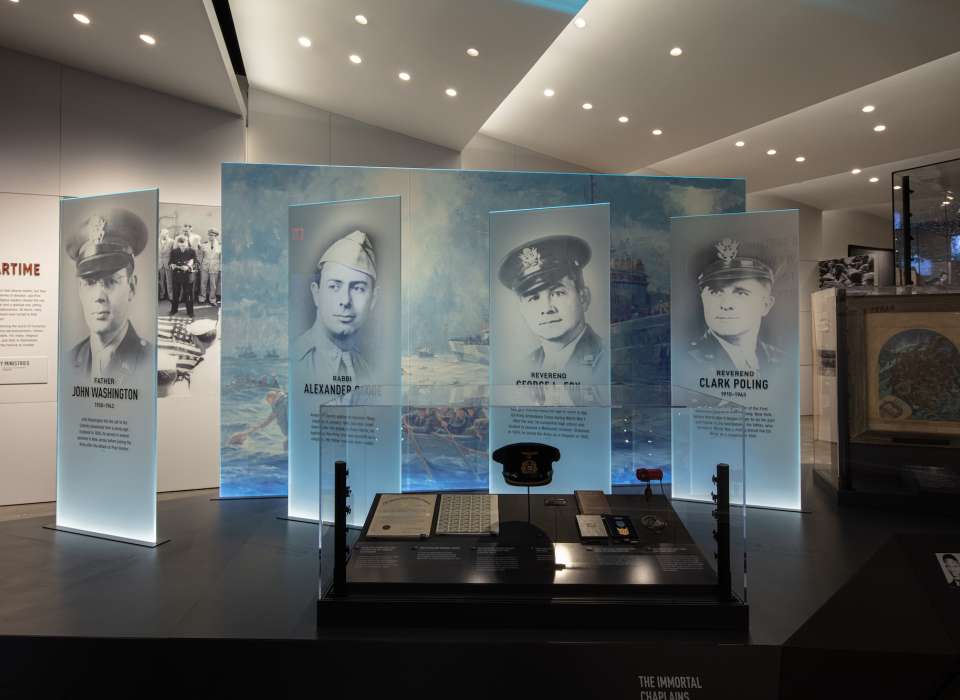
Frank and Paulette Stewart Interfaith Chapel
Adjacent to the Faith in Wartime gallery, the Frank and Paulette Stewart Interfaith Chapel honors the critical role of faith in World War II. In this reverential space for meditation and contemplation, visitors will have an opportunity to reflect on the stories presented in the Museum as well as their own personal journeys. The chapel opens out to the Col. Battle Barksdale Parade Ground on days with pleasant weather and for special occasions, allowing sunlight and fresh air to fill the stunning space.
Made possible through a gift from Frank and Paulette Stewart. Additional support provided by Baptist Community Ministries.
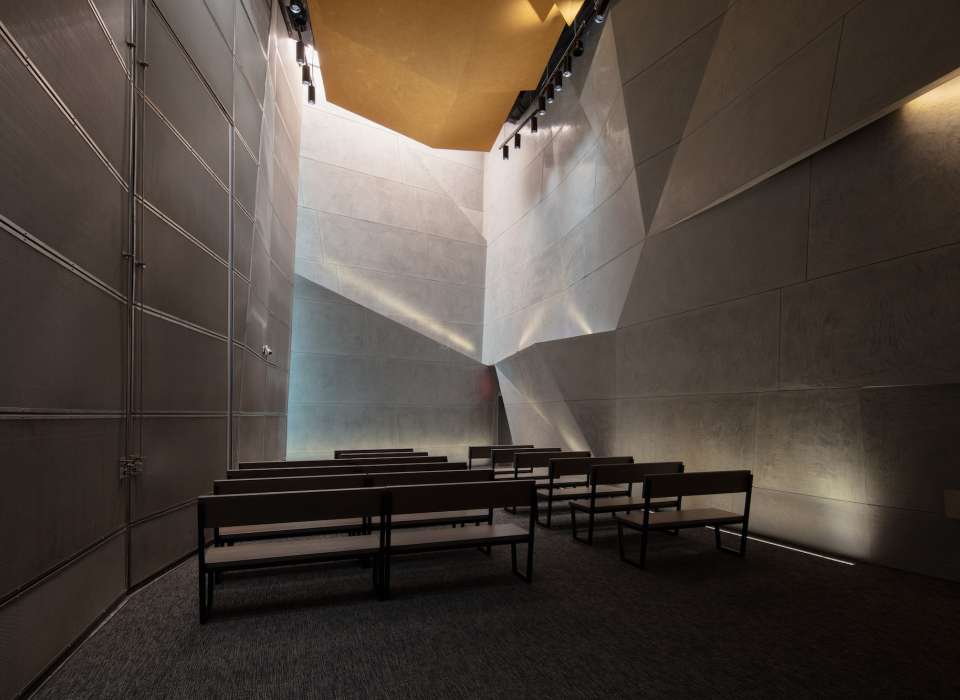
The Monuments Men and Women
The magnitude of looting by the Nazis during World War II, in particular the premeditated theft of art and cultural treasures, was unprecedented. During World War II, the United States, United Kingdom, and other Western Allies established a program to protect monuments and other cultural sites as well as locate and return stolen objects to their rightful owners. Implementing this selfless policy fell to a group of Allied scholar-soldiers known today as the Monuments Men and Women. This gallery includes an immersive “salt mine,” a narrated film, and a room filled with re-creations of art saved by the Monuments Men and Women.
Made possible through a gift from Mr. and Mrs. Robert Tucker Hayes. Additional support provided by Levy Rosenblum Family Foundation, Jay H. Frankel, The C. Jeffrey & Katherine J. Knittel Charitable Foundation, Deborah G. Lindsay, and the Monuments Men and Women Foundation.
Museum Campus
Explore The Campus
Museum Campus Guide-
Louisiana Memorial Pavilion
The Louisiana Memorial Pavilion exhibits take visitors into the monumental efforts on the Home Front and to the beaches of Normandy—focusing on the thousands of men and women who made Allied victory in World War II possible.
-
Campaigns of Courage
In a war where the terrain was as deadly as the enemy, this pavilion tells the story of American servicemembers abroad—and how they overcame unprecedented challenges on multiple fronts to win victory in World War II. In over 19,000 square feet of exhibit space, two extraordinary exhibitions bring visitors inside the epic story of the war in its most infamous settings, bringing to life jungles, beaches, mountains, and oceans in 19 immersive galleries.
-
Solomon Victory Theater
The Solomon Victory Theater is home to Beyond All Boundaries, a 4D cinematic experience produced exclusively for The National WWII Museum by Tom Hanks—who narrates the film—and Phil Hettema.
-
Hall of Democracy
The Hall of Democracy represents the center of the Museum’s expanding educational outreach initiatives—providing a space that will enable the institution to share its collections, oral histories, research, and expertise with audiences across the world.
-
US Freedom Pavilion
In World War II—the war that changed the world—freedom hung in the balance. Americans answered the call to protect that freedom with 16 million men and women serving in uniform and an untold number of citizens of all ages doing their part on the Home Front. In US Freedom Pavilion: The Boeing Center, we honor their contributions.
-
The Higgins Hotel & Conference Center
The official Hotel of The National WWII Museum, this stunning art-deco style property offers first-class accommodations, meeting spaces, and dining options providing a sophisticated lodging experience for guests.
-
John E. Kushner Restoration Pavilion
The John E. Kushner Restoration Pavilion will offer up-close looks at WWII macro-artifacts, including the Museum’s patrol torpedo boat, PT-305, which returned to campus in 2022. The Pavilion also houses the STEM Innovation Gallery, a vibrant educational space for students and teachers alike that shows how science, technology, engineering, and math contributed—and advanced—in World War II.
-
Founders Plaza
Founders Plaza creates an impressive entryway to the Museum campus, safe passage for Museum guests, and a pleasant setting for rest and reflection as part of the visitor experience.
-
Bollinger Canopy of Peace
The soaring Bollinger Canopy of Peace, set to stand 150 feet tall, will unify the Museum's diverse campus and establish the Museum as a fixture on the New Orleans skyline.
-
Liberation Pavilion
Three building levels will explore the closing months of the war and immediate postwar years, concluding with an explanation of links to our lives today.
